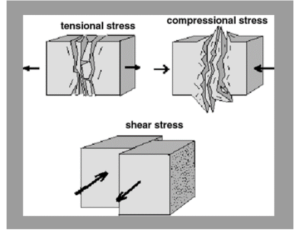Stress is a measurement of how much deforming force is applied per unit area of an object. Shear and tensile stress are two types of stress in which force is imparted to an item in different ways. When a deforming force is applied at right angles to a surface, it is called tensile stress. Shear stress, on the other hand, occurs when a deforming force is applied parallel to the surface. Shearing, on the other hand, is the process of parallel layers sliding past one another.
To get a parallelogram cross-section, we can push a stack of papers or a pack of cards with a rectangular cross-section. So, in these circumstances, the angle between the sides changes, but everything is actually happening in parallel. We’ll look at what shearing stress is and how to calculate it in this post, as well as some examples from real life.

Deformation occurs when an object is subjected to an external force. If the force is directed parallel to the object’s plane, the deformation will occur along that plane. As a result, you can see that the object is subjected to shear or tangential stress.
It occurs when the force vector components are parallel to the cross-sectional area of the material. The force vectors in normal or longitudinal stress are perpendicular to the cross-sectional area on which they act.
Overall, shearing stress is a type of stress that acts parallel to a material cross-section. Shear forces cause this to happen. They are the forces that act in the same magnitude and opposing direction on opposite sides of a body.
Shear stress is also a vector quantity. In other words, the magnitude is accompanied by the direction. The # Greek alphabet τ- is used to represent it. Shear stress is measured in N/m2 or Pa in SI units.
Fluid Shearing Stress
Shear stress can also be observed in fluids. When a fluid flows within a solid boundary, we may see shear stress and the point of contact between the fluid and the boundary.
Fluid is made up of distinct levels that travel at varying speeds. The layers at the same height from the border will move at the same rate. Shear stress is primarily responsible for the varying speeds between the strata.
Next, stress and strain in fluids are linked in several ways. To put it another way, shearing stress is proportional to strain rate, with viscosity as the proportionality constant.
Shearing stress Formula
The average shear stress can be calculated using the force per unit area ratio:
τ=F/A
The shear stress is denoted by , and the applied force is denoted by F. Finally, A denotes the cross-sectional area that is parallel to the force vector.
Shearing stress Causes
Shear stress occurs as a result of shear forces. They are a pair of forces of the same magnitude and opposite direction operating on opposite sides of a body.
The amount of force per unit area perpendicular to the axle of the member is called shear stress. The impact force on the wooden stick created two sorts of strains when you stomped on it really hard:
- Bending stress, also known as flexural stress, runs parallel to the member’s axle.
- The member’s axle is perpendicular to the shear tension.
Conclusion
You’ll be amused to learn that you’re surrounded by shearing tension from the moment you wake up and get out of bed until the moment you return to sleep. It’s because stress is present in practically every aspect of our daily lives. So, in order to gain a better understanding, we’ll look at some real-life situations.
Cutting of any kind is one example (when you cut fruits, vegetables, trees, paper, cloth and more). Then comes painting, brushing, and applying creams or other products such as soap, lotion, ointment, and other such items.
It is also an example when you eat feed between your teeth. Then, as you walk or run, your feet push the ground back to propel you forward. Similarly, the seat’s surface is subjected to shear stress when a moving vehicle starts or stops.
Then there’s shear tension, which occurs when water flows over riverbeds. We can often see erosion as a result of this. In today’s world, one of the most common examples is when you slide your Smartphone screens.
 Profile
Profile Settings
Settings Refer your friends
Refer your friends Sign out
Sign out






